Sistas in STEM (SIS) Seeks to Provide Support for Minority Women in STEM
September 24, 2017
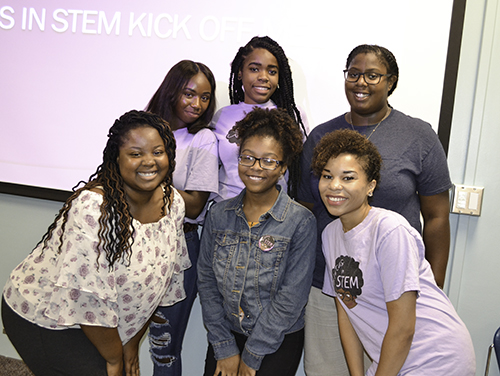
Sistas in STEM E-Board: Clockwise from bottom left: Shelana Martin, Belinda Grant, Stephanie Abdullah, Lyric Winston, Chezalyn Grant, and Mariah Mack.
Back in August of 2015, there didn’t seem to be a specific organization tailored to meet the needs and interests of minority women in STEM fields. So five women on campus, including Shelana Martin, decided to start one: Sistas in STEM, a Registered Student Organization (RSO) that’s geared toward the cultural background of minority women. “We wanted to hone in on that cultural aspect and give them a safe space for coming with their problems,” Shelana acknowledges. But it was also important that the organization take into account the fact that they’re women.
Shelana, 2017 SIS co-president, along with Chezalyn Grant, shares why she felt an organization for minority women in STEM was important. She admits that when she started out as a physics major, she was struggling with some classes. But even though she was a member of the National Society of Black Engineers (NSBE), it didn’t meet her needs.
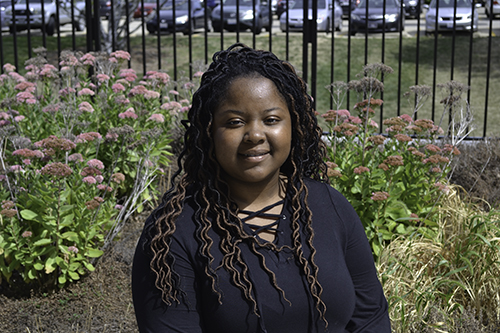
Shelana Martin, 2017 Sistas in STEM Co-President
“It was sort of male oriented,” she reports, adding that she felt like her opinion was dismissed a lot. “With SIS,” she explains, “it was about being able to get a broader expansion—so something that is not only related to me being Black, but also me being a woman.”
So the idea behind SIS was to provide a safe space for minority women, not just Black, but any minority…Latino, Pacific Islander, etc.…and give them a place where they could go to get the same benefits as someone in NSBE or Latino Students in Engineering. “We want to provide that kind of mentorship to women who haven't found an organization that they can be part of and get that experience with,” acknowledges Shelana.
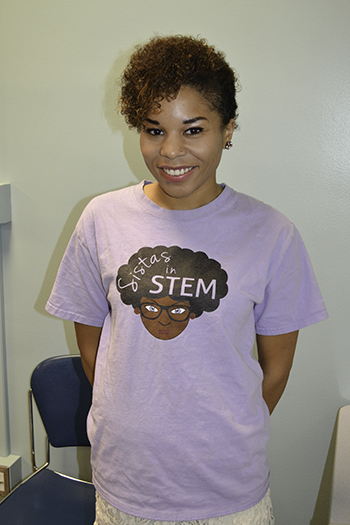
Chezalyn Grant, 2017 SIS Co-President.
Stressing that one of SIS’s strengths is community, SIS co-president Chezalyn Grant shares that, in fact, that’s why she joined Sistas in STEM: “in order to get a sense of community with other Black women who are in STEM fields, because Black women are underrepresented in STEM fields. I wanted to not only gain a sense of community, but I also wanted to learn more about my peers in STEM and gain support from them.”
Plus SIS’s goal isn’t to just focus on the “sisterhood between other women,” Shelana acknowledges, “but create a safe haven so they can get the professional experience.” So along with community, SIS offers professional resources, such as resume building and workshops on basics like what to wear to an internship or interview.
Since it was begun, SIS has grown to include 18 members, including 10 who actively serve on the Executive Board, or E-Board. In addition, 64+ girls joined the group’s email list this fall.
SIS activities throughout the academic year range in frequency from once a semester, to monthly, to even twice a week. For instance, an important, once-a-semester event is the Fall Kickoff, designed to introduce SIS to the campus and to give students, especially incoming freshmen and others who signed up on Quad Day, an idea of what the organization is all about.
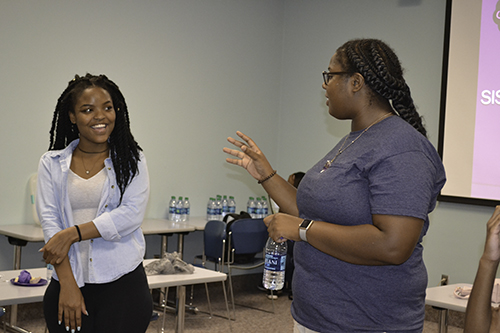
Two SIS members interact during an icebreaker at the recent Fall Kickoff event.
During the recent Fall 2017 Kickoff held on September 14th, after an icebreaker, co-presidents Chezalyn and Shelana gave a brief introduction, and introduced the members of the E-Board and the committees: Fundraising, Professional Development, Outreach, and Social. After sharing what the organization is about, its mission, and what it stands for, as well as some of the benefits of membership, they opened the meeting up for questions. In addition, interested students could sign up on the email list, or even to be involved in one of the committees.
Another of SIS’s main activities is its annual Professional Development Luncheon usually held in April. It features a panel of mainly minority women who teach at the university or are professionals in a range of STEM fields. During the panel, the women share about their experiences, their backgrounds, what they do, and how they navigated college, followed by a time for questions and networking.
SIS has about one social activity once a month, usually focused on academics and professional topics, plus general meetings that are once a month.
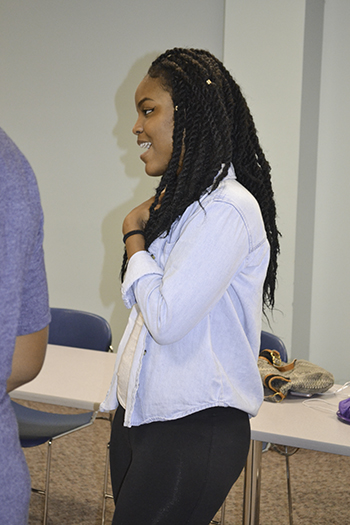
Angela Ellison participates in the icebreaker at the recent Fall Kickoff.
In addition, throughout the semester, SIS has a number of events, such as fundraisers and workshops. And finally, twice a week (and more often as finals approach), SIS reserves study tables, such as in Grainger Engineering Library, for members to study together and receive extra help, if needed. According to Chezalyn, this is another reason for belonging to SIS: “to join study groups and power through classes, eventually earning A's in hard classes.”
SIS appears to have lived up to its billing in the college careers of SIS members. Regarding the impact SIS has it made so far on her education at Illinois, Chezalyn, a senior in Psychology & African American Studies, with a concentration in Behavioral Neuroscience, Pre-Med, admits:
“It's made a huge difference for me, because I talk to other women who are in the same field as me. Most of the time we share a lot of the same classes. What Sistas in STEM does is put you in GroupMe's with other girls who are in the same classes or major as you, so that you can connect and join study groups—really strive for an A in the class. It helped improve my grades tremendously.”
In fact, Chezalyn recommends that new girls on campus meet as many girls as they can in order to network. “One of the girls they meet might be in the same class as them,” she adds, “and from there they might be able to help each other in the class so they can eventually get an A in it.”
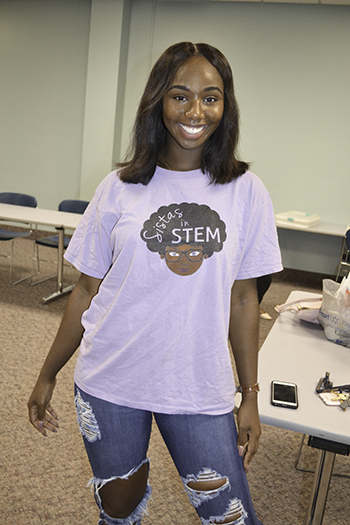
Belinda Grant, SIS’s Community Service Chair.
Similar to Cehzalyn, Belinda Grant, a senior in psychology, pre-physical therapy, and SIS’s Community Service Chair, reports joining the RSO for academic support. Her high school chemistry course hadn’t prepared her for college chemistry, and because she didn’t have anyone to do pre-labs or Lon Cappa homework with, she was struggling.
“By joining Sistas in STEM,” she explains, “I was able to connect with people in my classes or people who had already taken the classes already. That helped me out, because they would still remember the topics or say ‘Oh, you could go to the CLC,’ and that's how I was able to access other resources on campus to help me get through.”
Like Chezalyn, Belinda also has a piece of advice for freshmen: “Do not lose sight of what you're aiming to do. Even though classes get hard and you're going to get tired, you have to just push. Those nights that you stay up in the UGL while you're working and everyone else is having fun, it's all going to pay off in the end. Just keep going; keep smiling, you'll get there.”
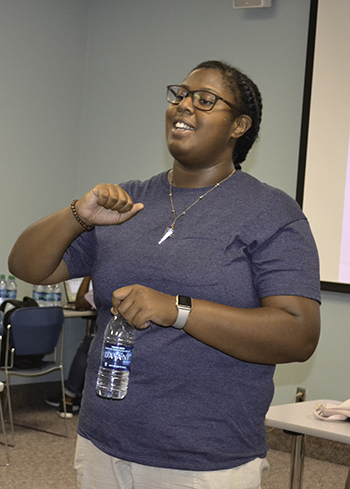
SIS Vice President Lyric Winston participates in the icebreaker at the RSO's recent Fall Kickoff event.
For Shelana, a senior in the College of Education’s Learning and Educational Studies program, with a concentration in DELTA (Digital Environment Learning and Teaching Agencies) and a minor in Informatics, she hopes to leave a legacy on campus, and shares how she hopes SIS can fill that niche for her personally.
“Not only would I be helping in starting something that could culturally be beneficial towards myself, I felt it would be something that I helped accomplish—making this organization and making it big and known on campus. We don't just want to wipe away all of the other organizations; we want to be a part of that group that pinpoints certain things that we want to see within our population, within our culture, and within the students.”
What impact do SIS members hope to have on students?
“Encouragement to keep going, to pursue more, to explore more,” says Shelana. “Perseverance. You may be in that class that's kicking you down a little bit, but to we want be that support group. We want people to say, ‘There is an organization that has been helping me. They have been a major part of why I'm still doing what I'm doing!’ I want them to be able to come back and tell other students once they have graduated and have gotten into their professions, that SIS is an experience that they won't forget because it has helped them a lot and been a part of their life since they joined.”
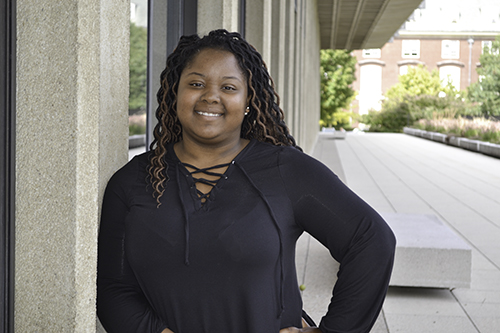
Shelana Martin outside the Education Builiding.
According to Shelana, SIS also hopes to impact younger women in high school or even elementary school. “We want to be able to show them they can have fun doing this; you can be a woman and be in STEM.” Part of that involves serving as role models younger students can emulate, as they “see a model that they can be interested in science and pursue that in college.”
So SIS also has an outreach component, and has worked with the C-U Boys and Girls Club, the Douglas Community Park Center, as well as Booker T. Washington STEM Academy. SIS is also partnering with the Urbana Neighborhood Connection Center at the YMCA beginning this fall, to do outreach activities there. Which ties in to another hoped-for impact: recruiting more young women into STEM.
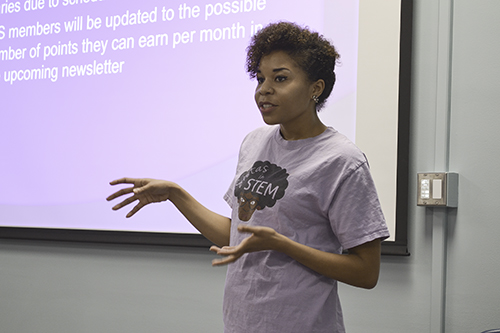
Chezalyn Grant shares about SIS during the recent Fall Kickoff event.
“Sistas in STEM is a really good organization for anybody of all races and ethnicities,” Chezalyn says. “It's really just a support network to help women become more involved in STEM fields so we won't be the minority in these fields. We can eventually conquer the world in all the STEM careers!”
Story and Photos by Elizabeth Innes, Communications Specialist, I-STEM Education Initiative
More: Student Organizations, Undergrad, Underserved Students/Minorities in STEM, Women in STEM, 2017
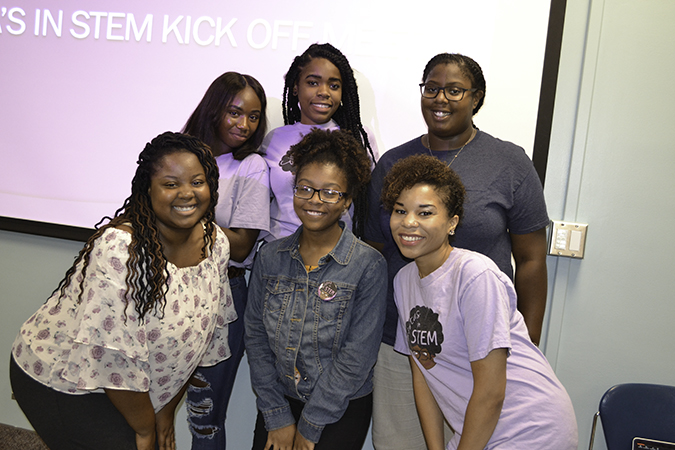
Sistas in STEM E-Board: Clockwise from bottom left: Shelana Martin, Belinda Grant, Stephanie Abdullah, Lyric Winston, Chezalyn Grant, and Mariah Mack.













.jpg)
















